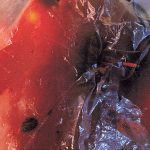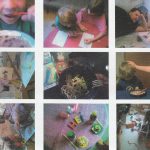“A Dialogue with Hunger” by Heidi Tikka
Title:
Artist(s) and People Involved:
Exhibiting Artist(s):
Symposium:
Artist Statement:
“A Dialogue With Hunger” excavates a compressed image of desire from the history of optics and cinema as well as that of psychoanalysis. The spectator’s desire constitutes the foundation of the cinematic apparatus that is used here to trigger the film projector. The female body as the site of the imaginary becomes the locus of the colliding forces of desire and violence. Simultaneously, the projection sets in motion a dispersion of the spectator positions. Who is looking and who is being looked at?
Installation “A Dialogue With Hunger” is part of a series of work, in which I have challenged the pleasure of looking. This challenge is posited from a feminist point of view and elaborates the notion of gendered gaze commonly presented in feminist film theory describing the pleasure of looking and the pleasure of control allowed by the act of looking being made only available for the male gaze in traditional cinema, in which the female body is only presented as the object of the gaze. In my pieces I look for strategies for making this controlling gaze encounter itself and thus depriving the pleasure momentarily from it. Rather than an image to be looked at the installation “A Dialogue With Hunger” is intended to function as a lure, a trap for catching the spectator in the process of seeing him or herself being found out looking. The piece consists of a white podium with a stereo-graphic viewer, a movie projector and an infrared sensor. When the spectator looks down into the slides the infrared sensor triggers the movie projector and the spectator becomes illuminated by the film projection. However, when the spectator looks up, the projection is interrupted. The projector thus functions in a double role: it projects the image but it also suggests the existence of a filming apparatus as a controlling device. This control does not only refer to the technical aspects of illumination and lens, but also to the psychological power of the film as the site of the imaginary in which the desire for mother’s body becomes replaced by the desire to see, but always remains unfulfilled. The images in the film loop reflect this process. The image of the infant being nursed fades into the recreation of the mirror scene in which I film myself through mirror. The latter also questions my identity as a female filmmaker and as the other of myself generated by these layers of reflecting and
penetrating surfaces. The stereographic image as the imaginary object of the gaze posits female body as the scene in which the violent forces of desire, fetishism, and anxiety collide.







